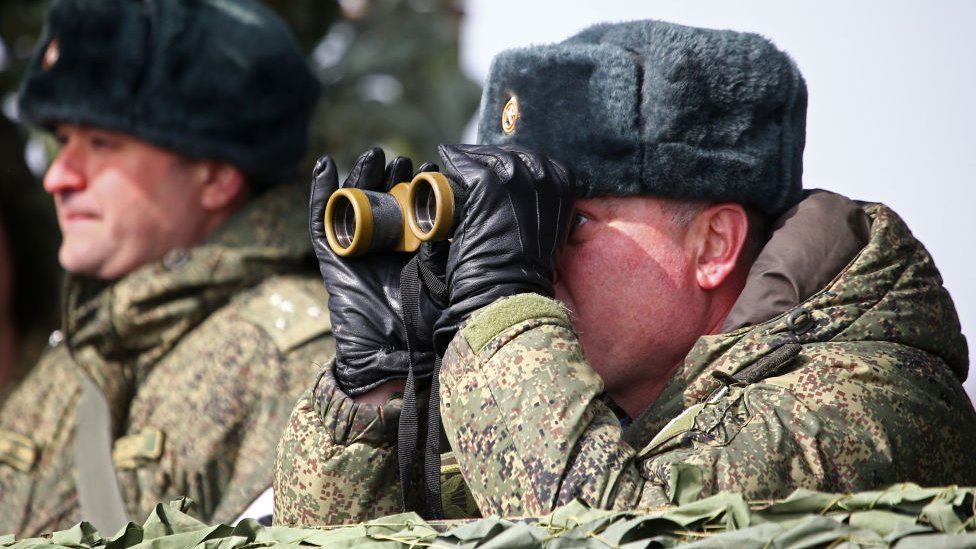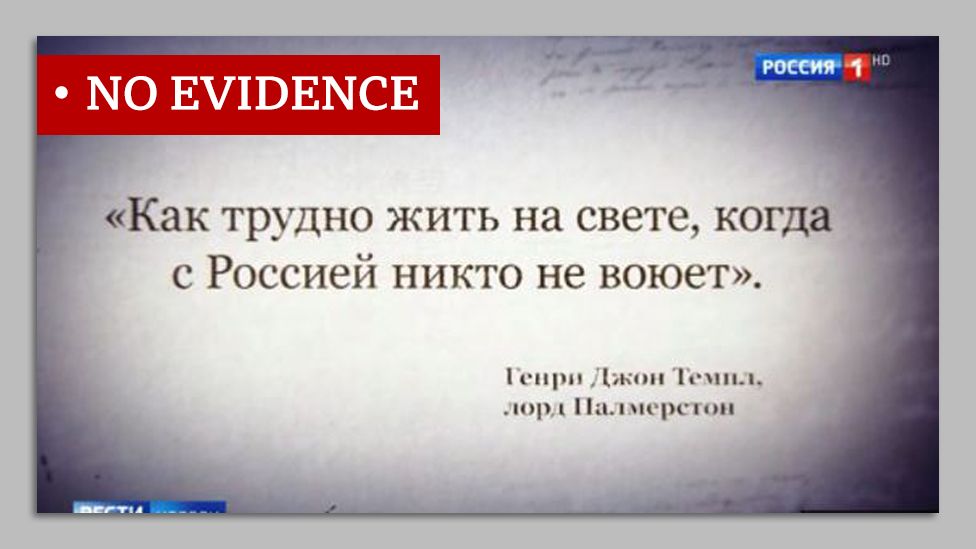
Russia has played down accusations of a military build-up near Ukraine's border - a view amplified by a state television channel, which has broadcast misleading footage about US tanks and planes.
We've fact-checked claims from one of the country's most well-known pro-government news shows - Vesti Nedeli ("News of the week").
The weekly news programme on Rossiya 1, Russia's most popular TV channel, is presented by Dmitry Kiselyov, a controversial media personality known for his anti-Western views.
An American plane lands in Alaska - not Ukraine
A recent report on the programme detailed the alleged build-up of Nato military hardware in Ukraine.
"Never before has there been so much of the alliance's military equipment on Ukrainian soil," said the narrator over footage of an American C-17 military transport plane landing on an airstrip.

But the aircraft did not, in fact, land in Ukraine.
The footage - apparently taken from the website of the US Department of Defense - actually shows the C-17 landing at Joint Base Elmendorf-Richardson in Alaska.
In the original version of the clip, mountains can be seen faintly in the background, but in the Russian version, they are not visible at all.
The Russian news report was sourced to a YouTube channel which says it broadcasts "US military news". That channel posted a slightly different and longer version of the plane landing. And the clip appears to have been brightened - an effect that obscured the mountains in the background.
But other details in the clip align exactly with the US Department of Defense video from Alaska. For instance, a white building, a small shack with a green roof, and other small details are visible in both pieces of footage.
There's no doubt the video clips came from the same source material - shot in Alaska, not Ukraine.
Old footage shows an American tank in Bulgaria - not Kyiv
The Vesti Nedeli report went on to suggest that American tanks have been delivered to Ukraine.

It showed a clip of a US M1 Abrams tank being unloaded from a military transport plane, with a voiceover suggesting that the footage was either from the capital, Kyiv, or Lviv, in western Ukraine.
In fact, the footage is from Burgas, Bulgaria, site of a military exercise called Operation Speed and Power in 2015.
Again, it's US Department of Defence footage - a video and still images of the unloading were published by the American military.
We managed to find the original footage by searching through lists of details of the military hardware in the clip.
And again the details in the two clips match up, proving the falsehood beyond a doubt. Both the original video and the footage shown on Russian TV contain identical details such as a Lukoil truck and a man wearing a high-viz jacket.
Tracking down a Lord Palmerston 'quote' - that he never said
The high profile show also featured discussion about how the US was allegedly "pushing" Ukraine towards war with Russia.
Mr Kiselyov, once dubbed Russia's "chief propagandist", referenced a quote from an unlikely source to lament his country's plight: Lord Palmerston, British Prime Minister during the Crimean War in the 1850s.
The presenter quoted him saying: "It's so difficult to live when no-one wages war on Russia."

It was a useful historical argument for Mr Kiselyov's views, with one problem - there's no evidence that Lord Palmerston ever said it.
BBC Monitoring's Russia specialists went in search of the quote but were unable to find a credible record of the former prime minister ever saying it.
The University of Southampton, which holds an extensive Palmerston collection, also found no record of him making these comments. According to the university's archivist, there are no references to it in Palmerston: A Biography by David Brown.
In Russia, Lord Palmerston's observations have been reported as part of a speech he made in the House of Commons on 1 March 1848. But the quote is not in the official transcript of that address.
The earliest mention of the remarks that we've found attributed to Lord Palmerston are contained in a work of historical fiction - published in 2011.
The same phrase appeared in a blog post of another Russian fiction writer two years later.
The BBC has attempted to contact Vesti Nedeli for comment.


Analysis by Adam Robinson, Russian media analyst, BBC Monitoring
The main impression being transmitted on Russian state TV seems be that Ukraine and the West are somehow responsible for the upsurge in tensions. But the programmes offer little in the way of details as to what exactly they did to spark the tension.
The gap has been filled by various, at times conflicting theories- a tactic used in the past by Russian state media when Moscow is accused of something, such as during the Salisbury poisonings.
At times, a West bent on weakening Russia is cast as egging Ukraine on, at other times, it is a supposedly bloodthirsty Ukraine trying to drag the West into a war of revenge against Moscow.
There has also been an emphasis on emotional coverage of victims of alleged Ukrainian aggression in the conflict area. Ukraine alleges that Russia is to blame for most ceasefire violations.
Another claim is that Ukraine and the West are massing forces in the region.
But again, details are sketchy, and the footage used to illustrate this has at times been out of date.
So Ukraine says any military activity on its side is a response to the recent Russian military build-up in the region.


https://news.google.com/__i/rss/rd/articles/CBMiI2h0dHBzOi8vd3d3LmJiYy5jby51ay9uZXdzLzU2NzcyMjk30gEnaHR0cHM6Ly93d3cuYmJjLmNvLnVrL25ld3MvNTY3NzIyOTcuYW1w?oc=5
2021-04-18 00:09:06Z
52781525080634
Tidak ada komentar:
Posting Komentar